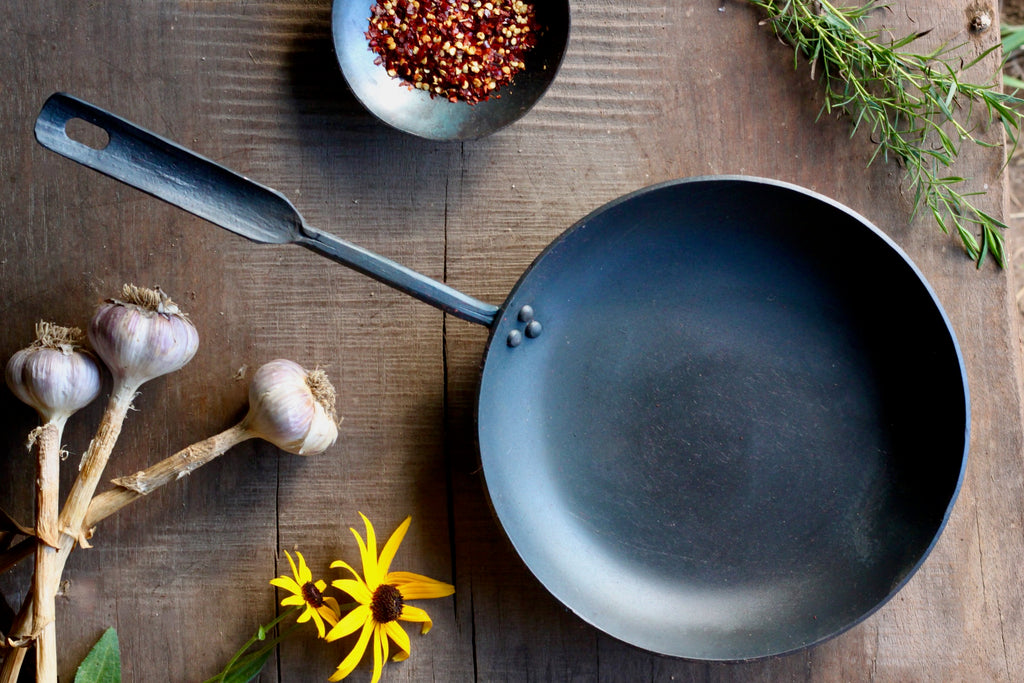The Story of the Wicks Forge 9A

The 9A is the first production run (A) of our 9" forged carbon steel skillet. It represents a year of research, design, prototyping, and finally, production. In a lot of ways, the story of how these pans came to be parallels the story of how Wicks Forge has developed over the years, meaning we used a lot of crazy tools. Some were really old (like 1800s civil war era old), others only kind of old (like after Prohibition), a few new, and many homemade.

The reason was simple. From the start our focus was on balancing aesthetics and functionality with accessibility. We didn't want to just make a handful of cool hand-forged pans; We wanted to come up with a process that would allow us to make cool hand-forged pans that were accessible to anyone. So that involved getting inventive.
Here's the story of how they came about.
Chapter 1: The design
I got my first cast iron pan at a flea market with my mom about 15 years ago and have been using it daily since. It is a Wagner No.10 from the 1950s. The pan is a workhorse and was the standard we used when designing our pans. However, there were three things about cast iron pans we wanted to improve on for our forged carbon steel pans.
1. The cooking surface
After that first flea market purchase, I became a collector of cast iron pans.
Different brands, styles, and ages all told me something about how production practices changed over time. One sad observation was that the older pans seemed to have a better cooking surface, while newer pans seemed to have a more pitted, bumpy, and therefore less non-stick surface even after seasoning.
The reason for this is that cast iron pans are literally made from casting molten iron. It seems that back in the day when cast iron pans were the prominent cookware in society, the casting process by certain companies was really dialed in–using both high quality casting techniques and high quality molds. In time, as cast iron pans became less ubiquitous, the process also became less refined.
We knew for our pans we wanted to create a nice smooth surface that would replicate the feel of cooking with a well seasoned, historic cast iron. Because our pans would be forged, not cast in a mold, we could use high-quality carbon steel sheets and control the quality of the final cooking surface.
2. The handle
Another problem with cast iron pans is the handles; they’re too short and you're always one careless grab away from burning your hand.
The reason cast iron handles are that way is once again tied to the process of making cast iron pans. They are literally cast in a mold and the type of iron used is strong, but brittle– so longer handles would be in danger of breaking.
With our pans we wanted something ergonomic that would also keep your hands away from the danger zone, no matter how much high heat cooking you're doing. By using forged steel handles we were able to add length with no risk of breakage, as unlike cast iron, carbon steel won't break.
3. The sides
What is the ideal angle and height of a pan wall?
It's a surprisingly hard question to answer and a lot of it depends on what you are cooking and how you like to cook. Are you frying or sauteing? Are you flipping pancakes or reducing sauces?
While some folks like to have a cooking tool for every task, we wanted our pans to be an everyday workhorse that were as versatile as possible. So, we worked with a chef to figure out the ideal sidewall height and curve for the every-pan pan.
It involved a great deal of research, dusting off the calculus books, and even diving into the world of skateboarding. As it turns out, the sidewall of a pan has a lot in common with the ideal curve of a skateboarding half-pipe.
Chapter 2: The Process
We now knew what we wanted to make, but the next question was how to turn this design into a viable product. For most products, we would start with making a few pieces, seeing how they sold, and if they did well, we'd start to refine the production process so we could make them more efficiently. But that wouldn't work for these pans.
Just to make the first pan, we needed a slew of new and custom tooling. Here's a look at some of them:
We used this lathe to make the dies that would shape the pans. Because we were working with such large diameter pieces of steel we needed a lathe with a large working radius. This beast in the above image was made in Worcester, Massachusetts in the 1870s.
At 150 years old, it's officially the oldest machinery in our shop. To put that in perspective, it was put to work before cars existed… that is, it would have been delivered from the factory with a horse and buggy. It was around when there were only 38 states, and before electricity was in widespread use.
We got this machine from a retired machinist who had worked at Bath Iron Works in Maine. This was his home lathe that he converted to run on an electric motor.
The electric motor was connected to an old truck transmission (which still has the gear shift!), which was then connected to the lathe so we could change speeds as needed.
As old as this machine is, it performed like a champ for us, and was tens of thousands of dollars more affordable than a modern day counterpart.

We stamped the logo with our homemade 25 ton hydraulic press.

Forging the pans with the fly press

Forging the handles
 Using the fly press to shape the tabs
Using the fly press to shape the tabs

Some of the custom tooling we made for bending and shaping the handles

Using a natural oil and beeswax finish to season the pans
As makers we might be biased, but the process of how things are made seem just as important as the piece itself. It's like the finished piece is the cover of a book with the pages written by the folks and machinery who put their time and love into that piece. This is why the tools themselves have a story to tell, which grows with time and expands across each piece they help create.
The story of these pans is also a story of Wicks Forge; the combination of ancient, modern, and homemade tools that were used to create something unique and accessible, while still maintaining our handcrafted philosophy.
Even with all the time and energy we put into these pans, we're most excited for the part of the story that’s yet to be written– the one about the years of good use and home cooked meals these pans will hopefully see for generations to come.


Laisser un commentaire